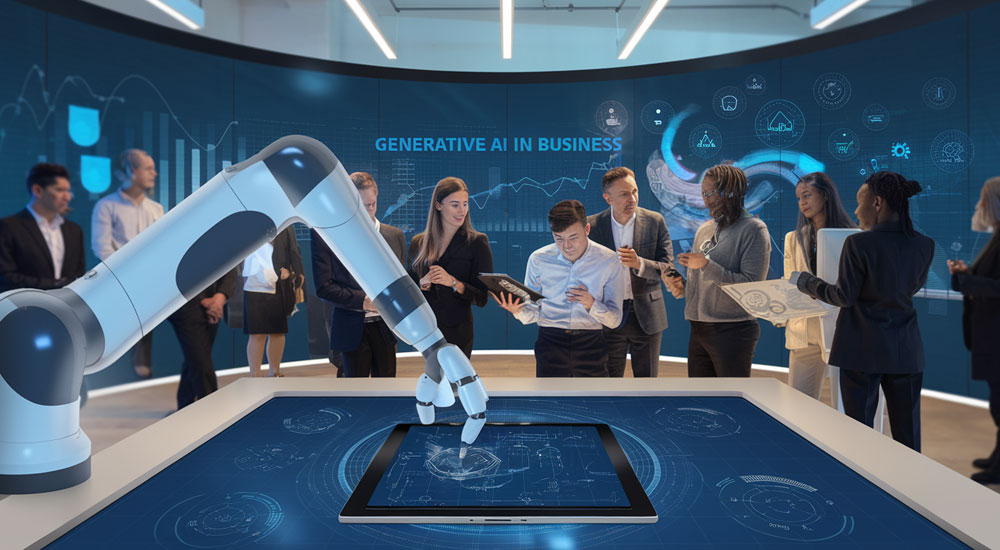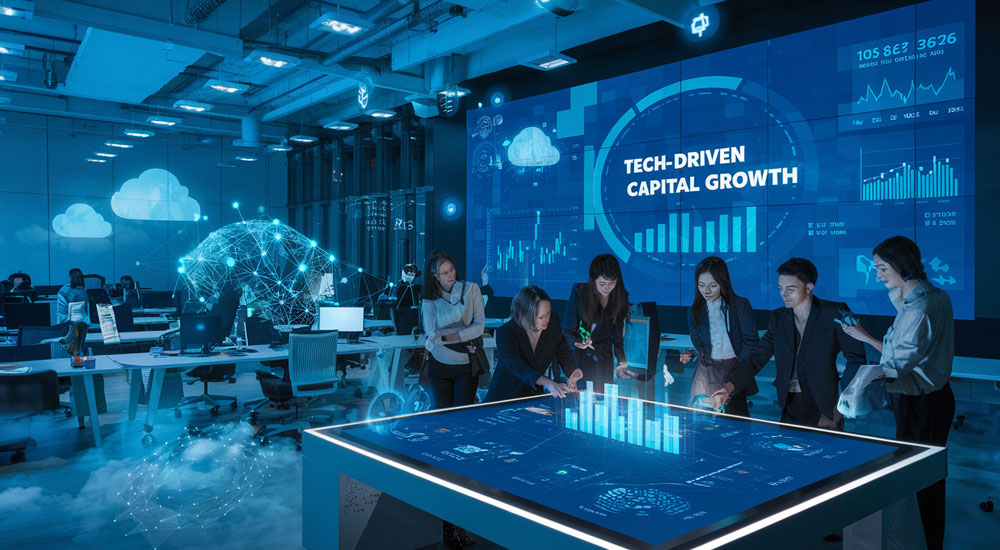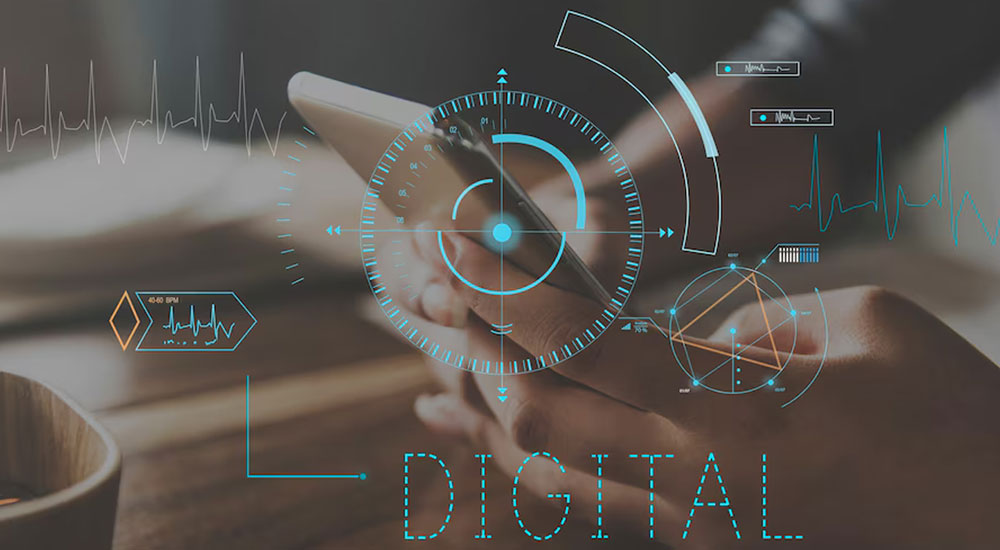Introduction

You’re a business owner, staring at a blank canvas, desperately seeking inspiration for your next big marketing campaign. 🎨💼 The clock is ticking, deadlines are looming, and your creative well has run dry. Sound familiar? Well, what if I told you there’s a groundbreaking solution that’s revolutionizing the way businesses approach creativity?
Enter Generative AI – the game-changing technology that’s transforming creative processes across industries. 🚀 This innovative tool is not just another passing trend; it’s a powerful ally that’s reshaping how businesses ideate, create, and execute their creative endeavors. From generating stunning visuals to crafting compelling content, Generative AI is opening up a world of possibilities that were once unimaginable.
In this comprehensive guide, we’ll explore how Generative AI is revolutionizing creative processes in business. We’ll dive into its applications across various sectors, uncover the key benefits it offers, and provide insights on implementation strategies. So, buckle up as we embark on a journey through the fascinating world of AI-powered creativity – your business’s next big breakthrough might just be a few algorithms away! 💡🔮
Understanding Generative AI in Business
Defining generative AI and its capabilities
Generative AI represents a groundbreaking subset of artificial intelligence that can create, produce, and generate new content, ideas, or solutions. Unlike traditional AI systems that are primarily focused on analysis and prediction, generative AI has the remarkable ability to create original outputs across various domains.
Key capabilities of generative AI include:
- Content Creation: Generating text, images, audio, and video
- Design and Prototyping: Creating product designs, architectural layouts, and 3D models
- Problem-Solving: Developing innovative solutions to complex business challenges
- Data Augmentation: Generating synthetic data for training other AI models
- Personalization: Crafting tailored content and experiences for individual users
These capabilities enable businesses to streamline creative processes, enhance productivity, and unlock new possibilities for innovation.
Key technologies driving generative AI
Several cutting-edge technologies power generative AI systems, each contributing to their impressive capabilities:
- Deep Learning: Neural networks that can learn and adapt from vast amounts of data
- Natural Language Processing (NLP): Enabling AI to understand and generate human language
- Computer Vision: Allowing AI to interpret and create visual content
- Generative Adversarial Networks (GANs): Two neural networks working in tandem to generate and refine outputs
- Reinforcement Learning: Enabling AI to learn and improve through trial and error
The synergy of these technologies creates powerful generative AI systems capable of producing high-quality, diverse outputs across various domains.
| Technology | Primary Function | Business Application |
|---|---|---|
| Deep Learning | Pattern recognition and data processing | Predictive analytics, customer behavior modeling |
| NLP | Language understanding and generation | Chatbots, content creation, sentiment analysis |
| Computer Vision | Image and video processing | Visual content generation, quality control |
| GANs | Content generation and refinement | Product design, virtual try-ons, data augmentation |
| Reinforcement Learning | Optimization and decision-making | Supply chain optimization, autonomous systems |
How generative AI differs from traditional AI
Generative AI represents a significant leap forward from traditional AI systems in several key aspects:
- Output Creation:
- Traditional AI: Focuses on analysis, classification, and prediction based on existing data
- Generative AI: Creates new, original content or solutions that didn’t previously exist
- Learning Approach:
- Traditional AI: Often relies on supervised learning with labeled datasets
- Generative AI: Utilizes unsupervised or semi-supervised learning, allowing for more creative outputs
- Problem-Solving:
- Traditional AI: Excels at solving well-defined problems with clear parameters
- Generative AI: Can tackle open-ended problems and generate multiple potential solutions
- Adaptability:
- Traditional AI: Generally performs specific tasks within predefined boundaries
- Generative AI: Demonstrates greater flexibility and can be applied to a wider range of tasks
- Creativity:
- Traditional AI: Limited creative capabilities, primarily focused on analysis and optimization
- Generative AI: Exhibits creative potential, generating novel ideas and content
By understanding these key differences, businesses can leverage the unique strengths of generative AI to drive innovation, enhance creativity, and unlock new opportunities for growth and efficiency in their operations.
How Generative AI is Revolutionizing Creative Processes
Now that we understand what Generative AI is and its potential in business, let’s explore how it’s revolutionizing creative processes across various industries.
Enhancing ideation and brainstorming
Generative AI is transforming the way teams generate ideas and brainstorm solutions. By analyzing vast amounts of data and identifying patterns, AI can suggest novel concepts and connections that humans might overlook. This capability significantly expands the creative boundaries of brainstorming sessions.
- AI-powered idea generation tools
- Collaborative AI platforms for team ideation
- AI-assisted mind mapping and concept visualization
These tools not only speed up the ideation process but also help overcome creative blocks and biases that can limit human thinking.
Streamlining content creation
Content creation is another area where Generative AI is making significant strides. From writing articles to creating social media posts, AI is streamlining the content production process.
| Content Type | AI Contribution |
|---|---|
| Blog posts | Generating outlines, drafting content |
| Social media | Creating engaging captions, suggesting hashtags |
| Video scripts | Developing storyboards, generating dialogue |
| Email marketing | Crafting personalized subject lines and body text |
While AI doesn’t replace human creativity, it serves as a powerful tool to augment and accelerate the content creation process, allowing creators to focus on higher-level strategy and refinement.
Automating design processes
Generative AI is also revolutionizing design processes across various fields, from graphic design to product development. AI-powered tools can:
- Generate multiple design variations based on specific parameters
- Optimize layouts for different platforms and screen sizes
- Create custom illustrations and graphics
- Assist in 3D modeling and prototyping
These capabilities not only speed up the design process but also enable designers to explore a wider range of creative possibilities.
Personalizing customer experiences
One of the most impactful applications of Generative AI in creative processes is its ability to personalize customer experiences at scale. By analyzing user data and behavior patterns, AI can:
- Generate personalized product recommendations
- Create tailored marketing messages and offers
- Develop customized user interfaces
- Produce dynamic content that adapts to individual preferences
This level of personalization was previously impossible to achieve manually, but Generative AI makes it not only possible but also efficient and cost-effective.
As we’ve seen, Generative AI is transforming creative processes in numerous ways, from ideation to personalization. Next, we’ll explore specific applications of this technology across various business sectors.
Applications of Generative AI in Various Business Sectors
Marketing and advertising
Generative AI is revolutionizing marketing and advertising by creating personalized content at scale. AI-powered tools can generate ad copy, social media posts, and even entire marketing campaigns tailored to specific target audiences. This technology enables businesses to:
- Produce high-quality content faster and more efficiently
- Create personalized messaging for different customer segments
- Optimize ad performance through predictive analytics
Here’s a comparison of traditional vs. AI-powered marketing approaches:
| Aspect | Traditional Marketing | AI-Powered Marketing |
|---|---|---|
| Content Creation | Manual, time-consuming | Automated, rapid |
| Personalization | Limited, broad segments | Highly personalized, individual-level |
| Testing | A/B testing, slow iterations | Multi-variate testing, real-time optimization |
| Analytics | Retrospective analysis | Predictive and prescriptive analytics |
Product development and innovation
In product development, generative AI is transforming ideation and prototyping processes. By analyzing vast amounts of data on consumer preferences, market trends, and technical specifications, AI can:- Generate novel product concepts
- Optimize existing product designs
- Predict market reception for new products
Customer service and support
AI-powered chatbots and virtual assistants are enhancing customer service experiences by:- Providing 24/7 support
- Handling multiple inquiries simultaneously
- Offering personalized recommendations based on customer history
Financial services and analysis
In the financial sector, generative AI is being used for:- Risk assessment and fraud detection
- Algorithmic trading strategies
- Personalized financial advice and portfolio management
Manufacturing and supply chain optimization
Generative AI is optimizing manufacturing processes and supply chain management through:- Predictive maintenance of equipment
- Demand forecasting and inventory optimization
- Route optimization for logistics
Design and branding
In the creative field of design and branding, generative AI tools are:- Generating logo concepts and brand identities
- Creating custom illustrations and graphics
- Assisting in UI/UX design for digital products
Key Benefits of Using Generative AI in Business Creativity
Efficiency and Speed: Automating repetitive creative tasks
Generative AI revolutionizes creative processes by automating time-consuming tasks, allowing businesses to produce high-quality content at unprecedented speeds. By leveraging AI algorithms, companies can generate multiple iterations of designs, copy, or multimedia content in a fraction of the time it would take human creators.
Scalability: Rapid expansion of creative workflows
With generative AI, businesses can easily scale their creative output without proportionally increasing their workforce. This scalability enables companies to meet growing demands and expand into new markets rapidly.
| Aspect | Traditional Approach | Generative AI Approach |
|---|---|---|
| Output Capacity | Limited by human resources | Exponential growth potential |
| Time to Market | Weeks or months | Days or hours |
| Adaptability | Slow to change direction | Quickly pivots to new trends |
Cost Reduction: Lowering expenses on content production
Generative AI significantly reduces the cost of content production by:
- Minimizing the need for expensive software licenses
- Reducing reliance on external agencies or freelancers
- Decreasing time-to-market, saving on labor costs
Personalization: Custom-tailored marketing and user experiences
AI-powered systems can analyze vast amounts of user data to create personalized content that resonates with individual preferences. This level of customization leads to:
- Higher engagement rates
- Improved customer satisfaction
- Increased conversion rates
AI-Human Collaboration: Enhancing rather than replacing human creativity
Generative AI serves as a powerful tool to augment human creativity, not replace it. By handling routine tasks and providing innovative ideas, AI empowers creative professionals to focus on higher-level strategy and refinement. This collaboration results in more diverse and innovative outcomes, pushing the boundaries of what’s possible in creative industries.
Implementing Generative AI in Your Business
Assessing your organization’s AI readiness
Before diving into the world of generative AI, it’s crucial to evaluate your organization’s readiness for this transformative technology. Begin by conducting a comprehensive assessment of your current technological infrastructure, data management practices, and employee skill sets.
Consider the following factors when assessing AI readiness:
- Technical infrastructure
- Data quality and availability
- Employee skills and knowledge
- Leadership support
- Budget allocation
To help you gauge your organization’s AI readiness, use this simple scoring matrix:
| Factor | Low (1-3) | Medium (4-7) | High (8-10) |
|---|---|---|---|
| Technical infrastructure | Outdated systems, limited cloud capabilities | Mix of legacy and modern systems | Modern, cloud-based infrastructure |
| Data quality and availability | Siloed, inconsistent data | Some structured data, limited integration | Clean, well-organized data across systems |
| Employee skills | Limited AI knowledge | Some AI-aware employees | Team members with AI expertise |
| Leadership support | Minimal interest in AI | Cautious optimism about AI potential | Strong commitment to AI adoption |
| Budget allocation | No dedicated AI budget | Some funds available for AI projects | Significant investment in AI initiatives |
Choosing the right generative AI tools
Once you’ve assessed your organization’s readiness, the next step is selecting the appropriate generative AI tools for your business needs. Consider the following factors when making your choice:- Specific use cases and goals
- Integration capabilities with existing systems
- Scalability and customization options
- Vendor reputation and support
- Cost and return on investment (ROI)
Training employees on AI-assisted creativity
To maximize the benefits of generative AI, it’s essential to provide comprehensive training to your employees. This will help them understand the technology’s capabilities and limitations, as well as how to effectively integrate AI into their creative processes. Key areas to focus on during training:- Basic principles of AI and machine learning
- Hands-on experience with selected generative AI tools
- Best practices for prompting and guiding AI-generated content
- Ethical considerations and responsible AI use
- Collaboration between human creativity and AI assistance
Overcoming implementation challenges
As with any new technology, implementing generative AI in your business may come with its share of challenges. Here are some common obstacles and strategies to overcome them:- Resistance to change: Foster a culture of innovation and demonstrate the benefits of AI through pilot projects and success stories.
- Data privacy concerns: Develop clear data governance policies and ensure compliance with relevant regulations.
- Integration issues: Work closely with IT teams and vendors to ensure smooth integration with existing systems.
- Quality control: Establish robust review processes to maintain high standards for AI-generated content.
- Skill gaps: Invest in ongoing training and consider hiring AI specialists to support your team.
Ethical Considerations and Best Practices
Addressing bias in AI-generated content
When implementing generative AI in creative processes, addressing bias is crucial. AI models can inadvertently perpetuate societal biases present in their training data, leading to unfair or discriminatory outputs. To mitigate this:
- Diversify training data
- Implement bias detection algorithms
- Regularly audit AI-generated content
- Establish a diverse review team
| Bias Type | Description | Mitigation Strategy |
|---|---|---|
| Gender bias | Stereotyping based on gender | Use gender-neutral language and balanced representation |
| Racial bias | Unfair treatment based on race or ethnicity | Ensure diverse representation in training data and outputs |
| Age bias | Discrimination based on age | Include age-diverse perspectives and avoid ageist language |
| Cultural bias | Favoring certain cultural norms | Incorporate multicultural viewpoints and context |
Ensuring data privacy and security
Protecting sensitive information is paramount when using generative AI. Businesses must implement robust security measures to safeguard both their own data and that of their clients. Key practices include:- Encrypting data at rest and in transit
- Implementing strict access controls
- Regularly updating and patching AI systems
- Conducting regular security audits
Maintaining human oversight and creativity
While generative AI can enhance creative processes, it’s essential to maintain human oversight and preserve the unique value of human creativity. Best practices include:- Use AI as a tool, not a replacement for human creativity
- Establish clear guidelines for AI usage in creative workflows
- Encourage collaboration between AI and human creatives
- Continuously train staff on AI capabilities and limitations
Navigating copyright and intellectual property issues
Generative AI raises complex questions about ownership and copyright. To navigate these challenges:- Clearly define ownership of AI-generated content in company policies
- Ensure proper licensing and attribution for training data
- Stay informed about evolving copyright laws related to AI
- Implement systems to track the provenance of AI-generated content
Measuring the Impact of Generative AI
Key performance indicators for AI-enhanced creativity
When measuring the impact of Generative AI on creative processes, it’s crucial to establish and monitor key performance indicators (KPIs). These metrics help businesses quantify the value added by AI-powered creative tools and processes. Here are some essential KPIs to consider:
- Creative Output Volume
- Time-to-Market
- Idea Generation Rate
- Creative Quality Score
- Client/Customer Satisfaction
Let’s examine these KPIs in more detail:
| KPI | Description | Measurement Method |
|---|---|---|
| Creative Output Volume | Quantity of creative assets produced | Count of assets generated per time period |
| Time-to-Market | Speed of creative process completion | Average time from concept to final product |
| Idea Generation Rate | Number of unique concepts created | Count of distinct ideas produced in brainstorming sessions |
| Creative Quality Score | Assessment of creative work quality | Peer review ratings or client feedback scores |
| Client/Customer Satisfaction | Satisfaction level with creative output | Surveys, Net Promoter Score (NPS), or feedback analysis |
By tracking these KPIs, businesses can gain valuable insights into the effectiveness of their AI-enhanced creative processes and make data-driven decisions for improvement.
Affordable & Efficient Accounting for Startups & SMBs
Reduce costs, improve compliance, and streamline financial reporting with our remote accounting advisory services.
Evaluating ROI of generative AI implementation
To justify the investment in Generative AI for creative processes, it’s essential to evaluate the return on investment (ROI). This involves comparing the costs of implementation with the benefits gained. Here are key factors to consider when evaluating ROI:
- Cost Savings
- Reduced labor hours
- Decreased outsourcing expenses
- Lower revision and iteration costs
- Revenue Growth
- Increased sales due to improved creative output
- New revenue streams from AI-generated products or services
- Productivity Improvements
- Faster project completion times
- Increased creative output per employee
- Quality Enhancements
- Higher client satisfaction rates
- Improved brand perception
To calculate ROI, use the following formula:
ROI = (Net Benefit / Cost of Investment) x 100
Where Net Benefit is the total value gained minus the total cost of implementation.
Tracking productivity and efficiency gains
One of the most significant impacts of Generative AI on creative processes is the potential for substantial productivity and efficiency gains. To effectively track these improvements, consider the following metrics:
- Time Saved per Project: Compare the average time taken to complete projects before and after implementing Generative AI.
- Resource Utilization: Measure how efficiently team members are utilizing their time and skills with AI assistance.
- Iteration Reduction: Track the number of revisions required for each creative project and compare it to pre-AI implementation data.
- Scalability: Assess the ability to handle increased workload without proportional increases in resources or time.
- Error Reduction: Monitor the frequency and severity of mistakes in creative outputs.
To visualize these gains, consider using tools like productivity dashboards or time-tracking software that can integrate with your AI systems. This will provide real-time insights into how Generative AI is impacting your creative workflows.
As we move forward, it’s important to remember that measuring the impact of Generative AI is an ongoing process. Regular assessment and adjustment of your measurement strategies will ensure that you’re accurately capturing the value of AI in your creative processes.
Future Trends in Generative AI for Business
Emerging technologies and their potential impact
As generative AI continues to evolve, several emerging technologies are poised to revolutionize creative processes in business. These advancements will likely shape the future of AI-driven creativity and innovation:
- Multimodal AI: This technology combines various forms of input and output, such as text, images, and audio, to create more comprehensive and versatile AI systems. Its potential impact includes:
- Enhanced content creation across multiple formats
- Improved user experiences through seamless integration of different media types
- More sophisticated virtual assistants and chatbots
- Quantum AI: By leveraging quantum computing, AI systems can process vast amounts of data and solve complex problems at unprecedented speeds. The potential impact on creative processes includes:
- Faster and more efficient content generation
- More accurate predictive modeling for marketing and product development
- Enhanced optimization of creative workflows
- Neuromorphic AI: Inspired by the human brain’s structure and function, neuromorphic AI aims to create more efficient and adaptable AI systems. Its potential impact on creative processes includes:
- More intuitive and human-like creative output
- Improved learning capabilities for AI systems
- Enhanced ability to handle ambiguity and context in creative tasks
| Technology | Key Features | Potential Impact on Creative Processes |
|---|---|---|
| Multimodal AI | Combines multiple input/output formats | Enhanced cross-format content creation |
| Quantum AI | Leverages quantum computing power | Faster, more efficient creative workflows |
| Neuromorphic AI | Mimics human brain structure | More intuitive and adaptable creative output |
Predictions for AI-driven creative processes
As generative AI continues to advance, we can expect several significant changes in how businesses approach creative processes:
- Hyper-personalization: AI will enable businesses to create highly tailored content and experiences for individual customers at scale.
- Real-time content adaptation: AI systems will dynamically adjust creative output based on real-time data and user feedback.
- Collaborative AI: Human-AI collaboration will become more seamless, with AI serving as a creative partner rather than just a tool.
- Autonomous content creation: AI systems will be capable of generating complete creative works with minimal human intervention.
- Cross-cultural creativity: AI will facilitate the creation of content that resonates across diverse cultural contexts.
Preparing for the evolving AI landscape
To stay ahead in the rapidly changing world of generative AI, businesses should consider the following strategies:
- Invest in continuous learning: Encourage employees to stay updated on AI advancements and provide ongoing training opportunities.
- Foster a culture of innovation: Create an environment that embraces experimentation and risk-taking in AI-driven creative processes.
- Develop ethical frameworks: Establish clear guidelines for the responsible use of AI in creative processes, addressing issues such as bias and transparency.
- Build strategic partnerships: Collaborate with AI research institutions and technology providers to stay at the forefront of AI developments.
- Prioritize data quality and management: Ensure that your organization has robust data infrastructure to support advanced AI applications.
As we look towards the future of generative AI in business, it’s clear that the creative landscape will undergo significant transformations. By staying informed about emerging technologies, anticipating future trends, and preparing for the evolving AI landscape, businesses can position themselves to leverage the full potential of generative AI in their creative processes.
Conclusion
Generative AI is revolutionizing creative processes across various business sectors, offering unprecedented opportunities for innovation and efficiency. From content creation to product design, this powerful technology is reshaping how businesses approach creativity and problem-solving. By implementing generative AI tools and adhering to ethical guidelines, companies can unlock new levels of productivity and creativity while staying ahead of the curve in an increasingly competitive landscape.
As we look to the future, the impact of generative AI on business creativity will only continue to grow. To stay relevant and competitive, businesses must embrace this transformative technology and adapt their creative processes accordingly. By doing so, they can harness the full potential of generative AI to drive innovation, enhance customer experiences, and ultimately achieve greater success in the digital age.










